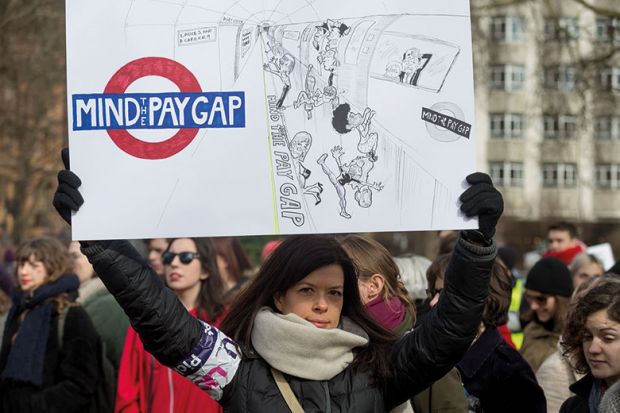As values-driven organisations, I hope that all universities will be committed to rewarding staff fairly, based on their contribution regardless of their personal characteristics. At the University of Essex, we have worked hard to turn our commitment to fairness in the workplace into action, through pay equality, decasualisation, treating students as employees when they undertake a teaching role and paying the living wage. We have made good progress, but we know that there is more that we can and must do.
The recent government requirement for all UK employers with more than 250 employees to publish their gender pay gap data has acted as an important prompt for a national conversation about fair pay for women. I also know that the release of the data and the comparison with other organisations and sectors has made for uneasy reading. This may make it tempting to seek to explain away the gender pay gap, or to acknowledge the issue without a firm commitment to act. Indeed, the absence of any requirement to act on the publication of the gender pay data has been the source of much criticism.
Understanding the gender pay gap data has been painful for us at Essex. Our university’s values make clear the importance of a diverse and inclusive environment in which we treat our members with equal respect and dignity. There are a range of dimensions to this: ensuring equal pay for work of equal value, so that women and men get paid the same for similar work; and closing the overall pay gap (defined as the difference between men’s and women’s average earnings across the organisation).
On the first of these, I am immensely proud to say that, having undertaken equal pay audits, we are confident that staff at our university, regardless of gender, receive equal pay for work of equal value. In October 2016, we were the first university to take the decision to eradicate the pay gap at professorial level – the one area we had identified where a gap existed between the pay of men and women doing similar work. We gave our female professors a one-off uplift in their salaries to ensure that their pay was equal to that of those males doing the same job. Subsequent regular reviews have confirmed that our equal pay gap remains closed. So having identified our problem, we found a solution and were prepared to fund it and to put in place ongoing monitoring and culture change actions to keep the gap firmly closed.
On the second dimension, the gender pay gap audit has highlighted that we still have an overall gender pay gap of 18.6 per cent. This is within the context of a higher education sector median pay gap of 15.6 per cent and a national gap of 9.7 per cent. This is unacceptable to us. We know that the reason for this is the unequal distribution of men and women across pay grades at the university. In particular, we have a higher proportion of women employed on the lower salaries of the more junior grades and a lower proportion employed on the higher salaries of the more senior grades – but we will not let this be a defence. Our experience has shown that it is within our power to take action and we are determined to close the gap completely as soon as we can.
We have set out specific changes to tackle issues of workplace culture and to change our recruitment processes and practices and have implemented these with immediate effect. These include: using positive action statements in all recruitment material; embedding unconscious bias training across the university; running academic promotion workshops and talent development programmes; encouraging staff to engage in informal networks; encouraging flexible working; putting in place career and peer mentoring schemes; identifying and raising the profile of role models; and putting in place robust processes to manage any variations to salary.
Over the past four years, our gender pay gap has fallen by 6.2 per cent. Five out of 11 of our senior leadership team are women (and 13 out of 25 of our governing body are women). We have increased our proportion of female professors by 5.7 per cent in the past five years to 29.8 per cent, which is 5.2 per cent above the sector average, and increased our proportion of female academic staff over the past four years by 2 per cent to 42 per cent in 2016-17.
Despite some progress, the government’s requirement to publish gender pay gap data should lead all universities to take a long, hard look at themselves in relation to one of the most important issues of our time. I find it shocking that education is the third worst performing sector and it is completely unacceptable that, nearly five decades after the Equal Pay Act of 1970, we still have a significant gender pay gap.
If the legislative requirements to respond to gender pay gaps are perceived as weak, the moral imperative to act is strong. Having gathered and published the data, we now have to be prepared at institutional level and as a sector to face up to the issues that have been highlighted and not just to acknowledge the scale of the challenge. By their very nature, universities are places of learning. Having identified that we have an issue, we are well placed to design and put in place solutions – but we have to be willing to do so. Taking action is not straightforward. There are no easy answers to what are complex problems and big legacy issues that reflect the inequality that exists in society.
At Essex, we are determined to use this moment to sustain our commitment to change and to learn from others. We know that ensuring that we are living according to our values requires will and decisive action, that we need to be realistic and that achieving change is likely to cost money and take time. But, having demonstrated over the past four years that, through our actions, we have made a difference, we are committed to doing more. Closing the gender pay gap both at Essex and across the sector will require significant workplace cultural change. This essential work will be difficult but it is not impossible.
Anthony Forster is vice-chancellor at the University of Essex.
POSTSCRIPT:
Print headline: The gender pay gap is clear to see. Now we need decisive action to address it
Register to continue
Why register?
- Registration is free and only takes a moment
- Once registered, you can read 3 articles a month
- Sign up for our newsletter
Subscribe
Or subscribe for unlimited access to:
- Unlimited access to news, views, insights & reviews
- Digital editions
- Digital access to THE’s university and college rankings analysis
Already registered or a current subscriber? Login







